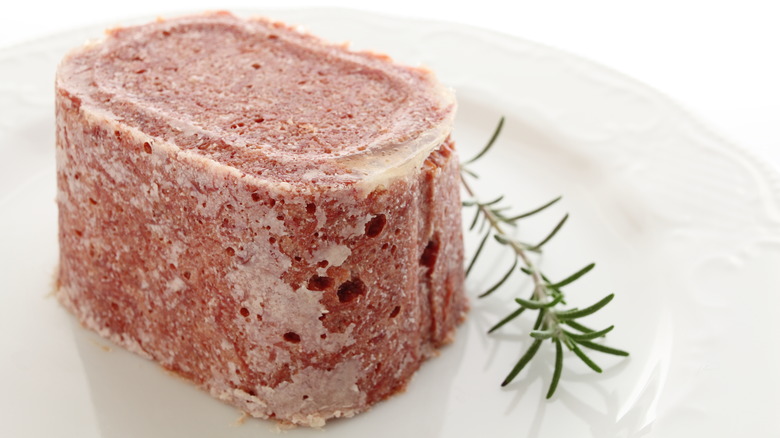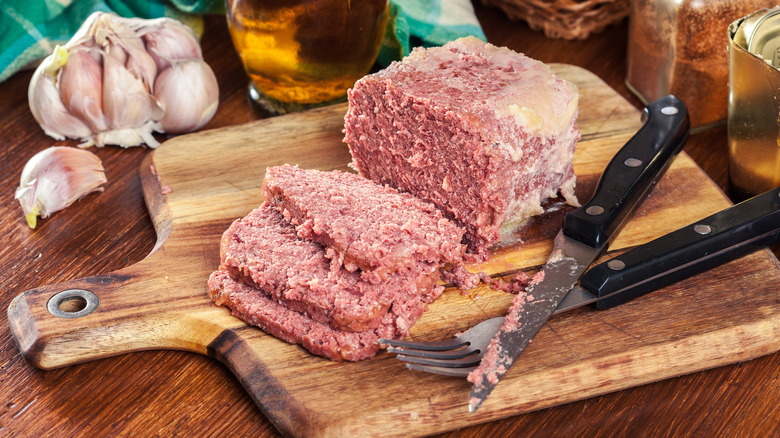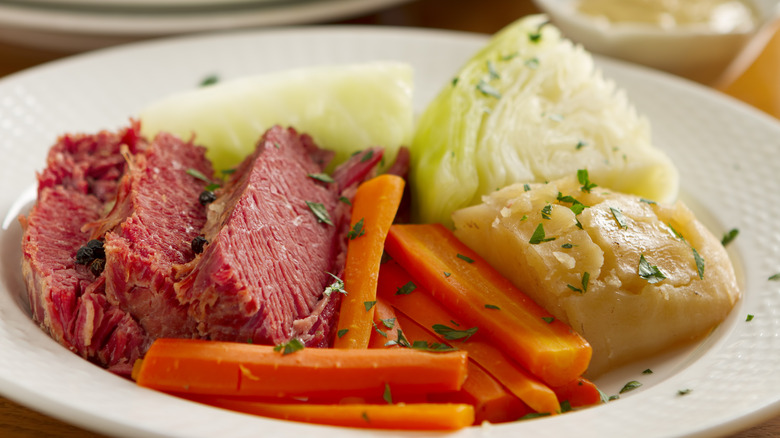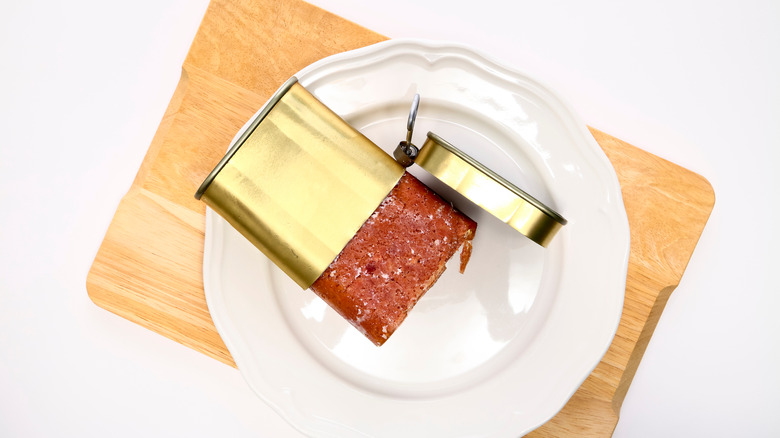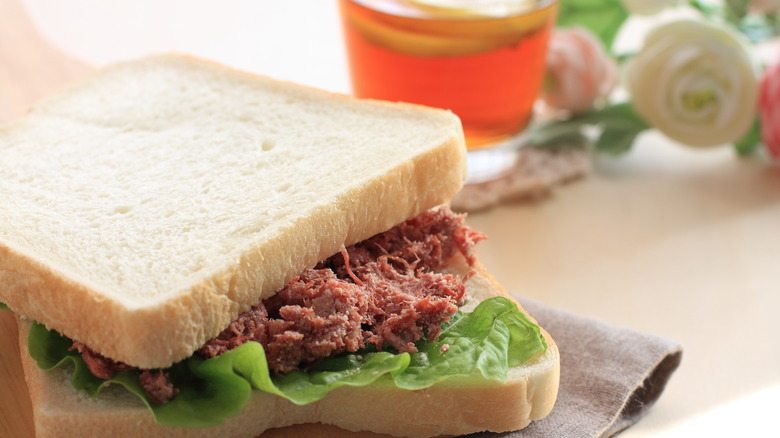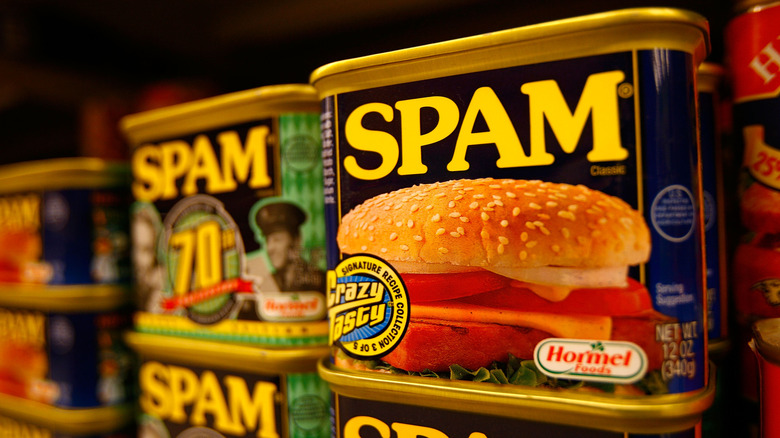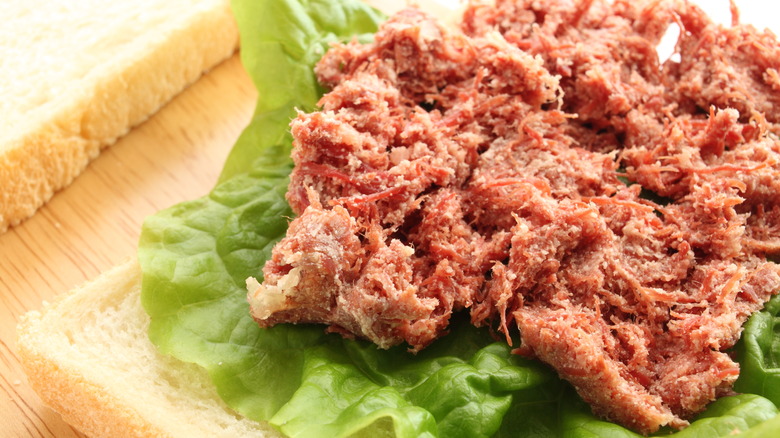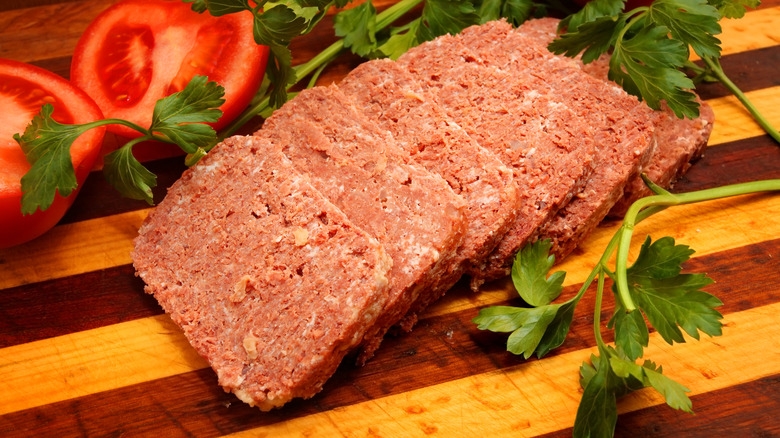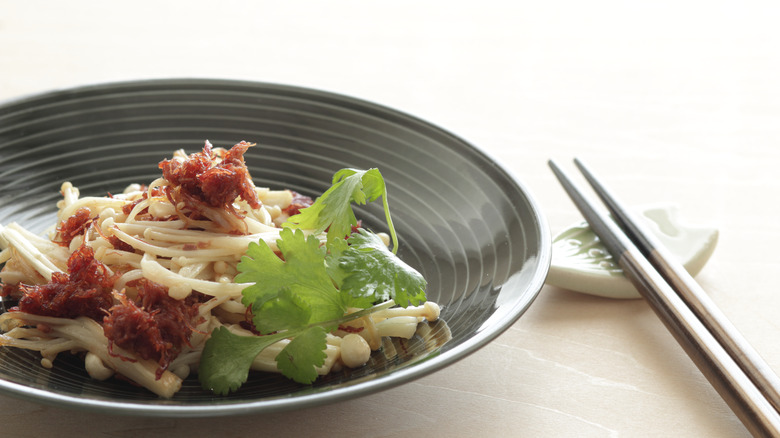Canned Corned Beef: 10 Myths Revealed
You know that can of corned beef that's been sitting in the back of your pantry for ages? While it's undeniably a classic staple in many a household, it's a food that's often misunderstood and riddled with misconceptions. But don't worry — we're here to set the record straight and break the myths surrounding this delicious and age-old canned good. From tackling the rumor that there's actual corn in there (spoiler alert: there isn't a single corn kernel) to exploring its global appeal and why it's way more versatile than you might think, we're diving deep into the world of this beloved canned meat.
So, if you've ever wondered if you can skip the cooking and dig in straight from the can, or if it's really a traditional Irish dish, stick around. You'll discover the surprising history behind the food's name, why it's a hit way beyond North America and Europe, and how it's not just a one-trick pony for sandwiches. Whether you're a corned beef aficionado or just a curious kitchen explorer, you're sure to gain some understanding and appreciation for canned corned beef. Get ready to learn everything there is to know in this canned corned beef guide.
1. Myth: There's corn in canned corned beef
One of the most enduring misconceptions about canned corned beef is its connection to actual corn. Many people when seeing the term "corned," might naturally assume it has something to do with the vegetable. But there's actually no corn in canned corned beef. The name "corned" beef actually refers to the traditional curing process for beef, which was preserved with large grains of salt, also known as "corns." These salt crystals were generously rubbed onto the beef to help draw out the moisture and prevent bacteria from growing in the meat. It also infused the beef with the salty flavor that we know and love.
Of course, times have changed, and so has the curing process that most canned corned beef goes through. Rather than being rubbed with salt crystals, the beef is typically injected with a pickling brine that helps to tenderize the meat and give it that salty flavor, without including any salt crystals whatsoever. But, the name stuck, and we still refer to it as "corned" beef, even to this day.
2. Myth: Canned corned beef is an Irish tradition
Corned beef is all but synonymous with St. Patrick's Day celebrations and Irish-American culture, but despite popular belief, it's not a traditional Irish dish. The roots of canned corned beef trace back to the Irish diaspora in America during the 19th and early 20th centuries. In Ireland, beef was considered a luxury meat primarily reserved for the wealthy, and was relatively scarce for the average household. On the other hand, salted pork was a more common meat among the Irish population. Pork was more accessible and affordable, making it a staple in Irish kitchens. So, how did corned beef become associated with Irish-American cuisine?
When waves of Irish immigrants arrived in the United States seeking refuge from the Great Famine and economic hardships in Ireland, they brought their culinary traditions and preferences with them, which included a penchant for pork. However, in their new homeland, beef was more readily available and affordable. Beef brisket, in particular, was a relatively inexpensive cut that when corned, provided a flavor profile somewhat reminiscent of the salted pork they were accustomed to in Ireland. It was a practical and cost-effective substitute for their traditional meats. Over time, corned beef became a staple on Irish-American tables, especially among working-class communities.
3. Myth: You can't eat corned beef out of the can
There's no getting around it. Canned corned beef doesn't exactly look appetizing out of the can. With a clumpy, wet texture and a unique pinkish color, it's understandable if you think that you need to cook it before eating it. But don't be fooled by the can; you can absolutely eat raw canned corn beef straight out of the can, and in fact, it makes an excellent meal on those lazy days when you can't be bothered to cook.
During the canning process, the beef gets fully cooked and/or preserved to perfection, before it's ever put into the can. Because the beef has been cooked and then heated during the canning process, it is safe to eat and doesn't require additional cooking or preparation. Corned beef retains its pink color even after cooking, so don't let the color put you off.
However, it's understandable if you don't find raw canned corned beef appetizing. Many people still prefer to cook their canned corned beef because it improves the flavor and the texture of the meat. Cooking helps mellow out the saltiness and crisp up the beef a bit.
4. Myth: Canned corned beef is most popular in North America and Europe
In the United States, one of the most popular ways to eat canned corned beef is by cooking it with cabbage on Saint Patrick's Day. It has a strong connection to Irish culture, and so the perception is that it's mainly a Western European food. But, canned corned beef is very popular worldwide, with a significant presence in Asia, South America, and the Pacific Islands, but it's perhaps most popular in the Philippines, where it's a well-loved staple and must-have for all kinds of dishes. It's a versatile ingredient used in various global cuisines, including Filipino sinangag (garlic fried rice), Brazilian pastel de carne, and many others.
One of the biggest reasons canned corned beef is so popular in Asian and Pacific countries is because of the World Wars in the first half of the 20th century. As American and British troops arrived in that part of the world, they brought with them their rations of canned foods like Spam and canned corned beef. Locals began using the canned meat and including it in their more traditional recipes, creating a brand-new culinary culture. The food was cheap and easy to transport, so it was widely available. Even after the Second World War ended, the demand for canned meats never died down, especially in the Philippines.
5. Myth: Canned corned beef is a 20th-century invention
Canned corned beef is by no means a modern invention. In fact, the concept of preserving meat in cans dates back to the late 18th century, but the credit for inventing canned meat, as we know it today, is often attributed to Frenchman Nicolas Appert. In 1810, Appert developed a method for preserving food in airtight glass jars by heating the food to kill bacteria, sealing it in a container, and then subjecting it to high temperatures to create a vacuum seal to prevent spoilage.
In the early 19th century, Appert's ideas were adopted by others, including British merchant Peter Durand, who patented the use of tin-plated iron cans for food preservation. These tin cans quickly replaced glass jars due to their durability and the fact that they could be hermetically sealed more effectively.
The use of canned meat, especially for military rations, became prominent during the 19th century and into the early 20th century. During both World War I and World War II, canned corned beef was a part of various military ration kits for U.S., Russian, and British soldiers. It served as a reliable and convenient source of sustenance for troops on the front lines, ensuring they had access to essential nutrients even in the harshest conditions of war.
6. Myth: Canned corned beef is the same thing as Spam
Both Spam and canned corned beef have a history of being used as convenient and long-lasting meat products for military rations. And sure, their rectangular cans are similar. So, it can be easy to confuse the two if you don't eat them often. However, there are several differences between the two that set them apart.
The biggest difference between the two is that they're made up of different kinds of meat. Spam, short for "spiced ham," is primarily made from cuts of pork shoulder and ham that are ground together, mixed with various seasonings, and then canned. The specific blend of spices used in Spam gives it its distinctive flavor. Canned corned beef, on the other hand, is made from beef brisket that undergoes a different curing and seasoning process than spam.
Spam has a characteristic savory and slightly salty taste due to the seasonings used. Its texture is relatively smooth and uniform, making it suitable for slicing or dicing. But, canned corned beef has a rich, beefy taste with a noticeable saltiness from the curing process. Its texture is typically coarser and less uniform than Spam, which some people prefer for specific dishes, but it doesn't hold its shape as well as Spam when slicing.
7. Myth: Canned corned beef is made from low-quality meat
When it comes to cost-saving foods, canned corned beef is some of the cheapest meat you can buy, and the prevailing wisdom is that you get what you pay for. Because of the low price tag on a can of corned beef, it's easy to assume that the meat must be bad or of poor quality. But in reality, canned corn beef is made with quality cuts of beef that are suited well for canning.
Canned corned beef can be made with various cuts of beef, but brisket is by far the most common cut that brands use. Brisket, known for its rich flavor and tenderness when prepared correctly, is far from being a low-quality meat. It's particularly well-suited for the corned beef process because the curing and slow-cooking method that it goes through helps to tenderize it. While brisket is indeed a flavorful cut, it's not as premium or expensive as some other cuts like ribeye or sirloin. This makes it a cost-effective choice for producing canned corned beef. And, the best corned beef brands will use quality cuts of meat regardless of its price.
8. Myth: It has a long shelf life because it's full of preservatives
There seems to be a misconception that canned corned beef is pumped full of artificial preservatives, and that it's much less healthy than regular beef brisket. While some brands may use preservatives, not all do, and the canning itself is the primary preservation method. The extended shelf life of canned corned beef primarily results from hermetically sealing the meat in an airtight container, which prevents spoilage on its own, without the use of preservatives.
When brands do use preservatives to extend the shelf life of corned beef, the main substance used is sodium nitrate. Sodium nitrate acts as an antimicrobial agent. It inhibits the growth of harmful bacteria, especially Clostridium botulinum, which can cause botulism, a severe and potentially life-threatening illness. By controlling bacterial growth, sodium nitrate helps ensure the safety and long shelf life of canned corned beef. It's also a curing agent that helps maintain the pinkish-red color of the meat, which is particularly important for corned beef's appearance. Some brands may choose to include preservatives for various reasons, including flavor and color enhancement and extra safety measures, but this isn't the standard practice for all brands across the board.
9. Myth: Canned corned beef is overly salty
It's true that canned corned beef does have a certain level of saltiness, primarily due to the curing process that involves generously seasoning a beef brisket with salt and injecting pickling brine directly into the meat. What might be too salty for one person could be just right for another, but the good news is that you can prepare your beef in certain ways to mellow out the saltiness or cut down on the salt in your beef altogether.
One of the best and easiest ways to make your corned beef less salty is to briefly soak or rinse it with water before cooking it. By washing off the liquid that the meat has been sitting in while it was canned, you get rid of a good amount of the salty flavor right off the bat. After a quick rinse or soak, pat the beef dry and proceed with your chosen recipe.
But, what if you'd like to avoid a high-sodium food like canned corned beef altogether? If you're conscious of your sodium intake or simply prefer a milder flavor, you're in luck. Certain popular canned corned beef brands like Libby's, Hormel, or Hereford offer low-sodium versions of their products that are specially designed to provide the same delicious taste with less salt.
10. Myth: It's only used for corned beef hash
Here's a myth that is limiting your culinary creativity — the idea that canned corned beef is only good for making corned beef hash. Sure, that's a classic and comforting dish and it's perfect for a quick and easy weeknight dinner, but it can be a little boring. You might not know that canned corned beef is a real kitchen superstar with more possibilities than you might think. From sandwiches and hearty stews to omelets, and even creative international dishes, it has a wide range of culinary applications beyond just hash.
For example, the classic Brazilian dish pastel de carne (fried beef pastry) can easily be made with canned corned beef rather than ground beef, if you're looking for a quick and easy version. And of course, Filipino cuisine is full of recipes that include canned corned beef, like Filipino corned beef hash over rice, or corned beef silog, a breakfast dish that includes garlic fried rice and is topped with a fried egg. Beef brisket, like the kind used to make canned corned beef, is a popular topping on Vietnamese pho. Or, you could try adding corned beef to your grilled cheese, tacos, or a classic Reuben sandwich.
